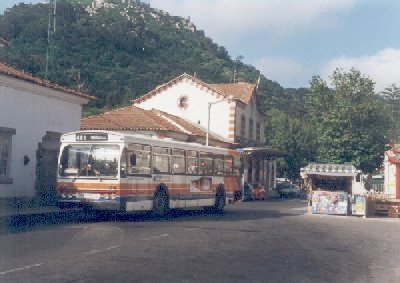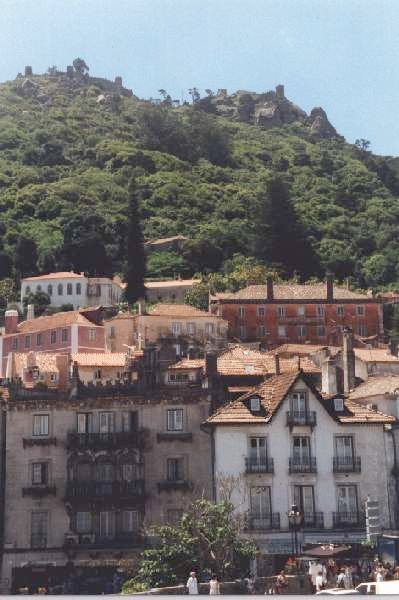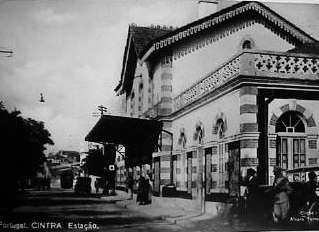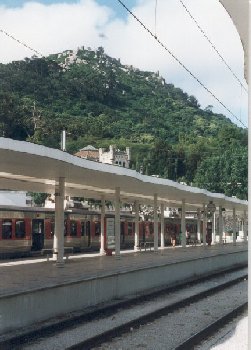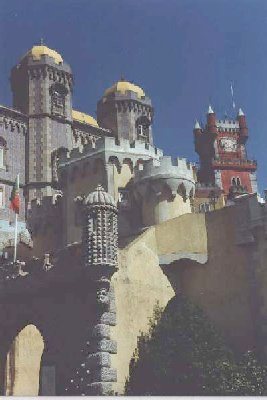It is cheap.
Part One of these Pages covers the services to Sintra from Lisbon. The main service traditionally ran from Rossio Station in central Lisbon but, during 2004, the tunnel which carries all lines out of that station had to be closed due to structural problems; but after many delays it was reopened by the Prime Minister on 16 February 2008. Sintra services resume running from Rossio from that date but Mira Sintra and Meleças services run from Roma - Areeiro, the new (2004), expanded four-track station created out of the formerly under-used Areeiro station in north Lisbon.
Part Two covers the services from Entrecampos-Poente and Oriente stations, including the former Alverca to Queluz-Massamá services, as well as providing information on rolling stock and ticketing.
The Services
The line between Sintra and Cacém was opened on 2 April 1887 and extended to the Lisbon suburb of Campolide by 1891.
Services on the Sintra Line are currently (during the Rossio closure) via three routes:
NB All of the above routes run through stations from Sete Rios (North West Lisbon, adjacent to the Jardim Zoológico Metro station) onwards to Sintra.

Services run virtually all day and night; from around 0500 hours to 0200. They are operated by the Unidade de Suburbanos de Grande Lisboa- USGL, a division of the national railway company CP, at whose Web Site,
timetables may be found.
The Lisbon Terminals
Estação do Rossio (Rossio Station)
NB Rossio Station is closed till summer 2006 - see above
Rossio CP station, not to be confused with the Metro station of the same name, is centrally situated, just to the NW of Rossio square, towards Restauradores, in the heart of Lisbon. The platforms are reached by a series of escalators from the front entrance. A new connecting walk way to the Metro has been opened but it should be noted that the Metro station to which it connects is NOT Rossio Metro station but Restauradores. See the Luso Pages Metro
Page for further information on the Metro system and the Lisbon RailwaysPage for more details on Rossio station. The underground walkway between Rossio CP and Restauradores incorporates a striking tiled mural of Ulysses near the Rossio end and also boasts its own café. The outside of Rossio station is well worth a close inspection. Its neo-Manueline style incorporates pseudo-Moorish arches and a statue of the 16th-century king, Sebastião.
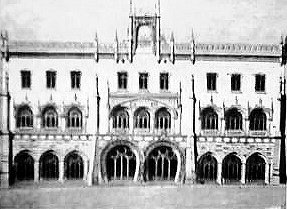
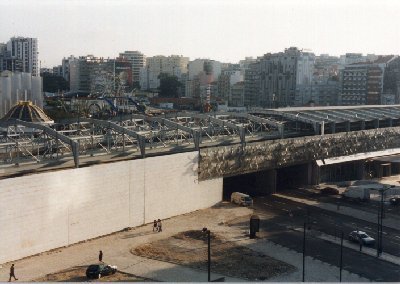
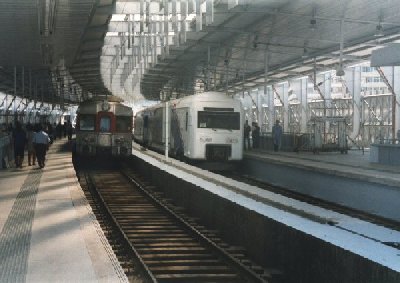
Left to right: Rossio Station; Entrecampos Station; a CP EMU and a Fertagus double-decker wait at Entrecampos, 1999.
Roma - Areeiro

The plaza outside Roma-Areeiro station, whose entrance is on the far left of the photo.
This station was created in 2004 out of the former Areeiro station. Onto the former unexceptional station has been grafted a long covered walkway which, apart from a column outside the frontage, bears no sign of its being a railway station. In style it is akin to the new structures at Sete Rios and Entrecampos and shares with them this lack of external signage. The Roma-Areeiro station is also poorly signed from the Metro. From Areeiro Metro it is also a five minute walk or so. The new station has four tracks and also now serves as the Lisbon terminus for Fertagus cross-Tagus services to Coina and Setúbal.
Estação de Entrecampos-Poente (Entrecampos West Station)
The Entrecampos station complex has five different names! The Metro system station, to which the CP railway station is connected by a lengthy walk-way, was traditionally styled Entre Campos (two words); the CP (Portuguese Railways) call the complex variously Entrecampos and Entrecampos Poente (Entrecampos West), or (until recently) Rego, or Avenida 5 de Outubro. The name Entrecampos itself refers to its location between Campo Grande and Campo Pequeno, two formerly open areas of the city. The multiplicity of CP names arises from the fact that the station has been rebuilt and extended. Entrecampos-Poente refers to the island platform, about 200 metres west of the main station, from which services to Meleças run at frequent intervals.
The main station of Entrecampos houses the Azambuja Line
services and was the original terminus for the Fertagus cross-Tagus double-decker EMU services, which began in July, 1999 but this rolw is now asigned to Roma-Areeiro. Rego and Terminal Avenida 5 de Outubro were names of stops just west of the original Entrecampos station, which have now effectively merged with it, to become what CP now most commonly calls Entrecampos-Poente. The station is still less than perfectly signposted internally with various levels which can make it confusing.
Entrecampos-Poente comprises a new island platform, with a passing track on the north side. To
the south of the track serving the southern side of this platform are six tracks which run into
Entrecampos station proper.
In the covered Entrecampos station itself, four tracks are used for the Azambuja services, including services which run to Alcântara-Terra, which is just a short walk from the Cascais Line, and also operated by USGL. Occasional through-running freight trains and locomotives also can be seen at Entrecampos heading for the docks. The booking office is on a lower level from the platforms but self-service ticket machines have also been installed.
Lisboa Oriente (Lisbon East Station)
This architecturally impressive station, to the north of Lisbon, served the Expo 98
site but is now an important railway station in its own right as it is more easily reached than the more central Santa Apolónia, Lisbon's terminal station. Oriente is linked by a fairly
lengthy and confusingly signed walk through the station shops to Oriente Metro station on the Red Line to Alameda. Essentially the station platforms are at the highest level, with the book offices (which are many and not clearly signed as to function) are on the level below. Further down is the Metro station. There is also a major bus station at the rear of the railway station. Services from Alverca on the Sintra Line mostly terminate at the newly named station of Monte Abraão (formerly Queluz-Massamá) or at Meleças. The line from Oriente passes through Entrecampos, where the trains stop in the main station rather than Entrecampos-Poente. See Part Two of this page for details of this service.
The Route
1: The Rossio Services
The route from Rossio to Sintra serves fifteen stations. All Rossio and Entrecampos-Poente services are provided by ADtranz class 2300 and 2400 EMUs of eight cars (two four-car units coupled together). The Alverca service is operated by class 3500 double-deck EMU stock, much of which is now looking rather shabby on the exterior.

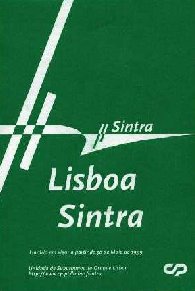
 17 February 2008 partly updated
17 February 2008 partly updated






 ROSSIO (0km)
ROSSIO (0km)
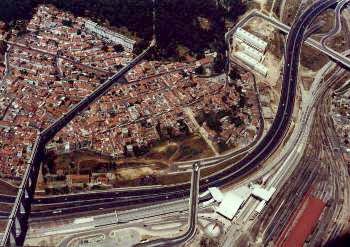
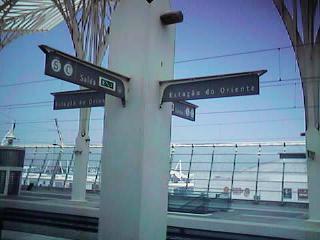
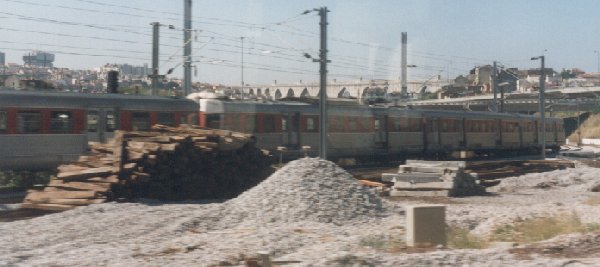
 CAMPOLIDE (4km)
Whilst Rossio was closed (till February 2008), Campolide was not served by the Sintra Line.
CAMPOLIDE (4km)
Whilst Rossio was closed (till February 2008), Campolide was not served by the Sintra Line.
 BENFICA (7km)
BENFICA (7km)
 STA CRUZ/ DAMAIA (8km)
This is a 1998 amalgamation of two previous stops at Santa Cruz de Benfica and Damaia. Indeed, on the right, approaching the station is the Centro Comercial de Damaia (shopping centre). To the left is a covered section of the Lisbon aqueduct and to the right is the built-up Buraca district. The layout is 1P2P1.
STA CRUZ/ DAMAIA (8km)
This is a 1998 amalgamation of two previous stops at Santa Cruz de Benfica and Damaia. Indeed, on the right, approaching the station is the Centro Comercial de Damaia (shopping centre). To the left is a covered section of the Lisbon aqueduct and to the right is the built-up Buraca district. The layout is 1P2P1.

 REBOLEIRA (10km)
This is a new station, completed in 1999, whose main feature is its colourful tile work, both on the Sintra-bound platform nameplate and in the station buildings to the right. The layout is P2P2P. On leaving Reboleira, to the left is the floodlit ground of the Estrela Amadora football team. The line turns to the right, where suburban blocks of flats abound on both sides. The extensive Adtranz/ Sorefame/ Bombardier train construction works are to the right of the main line; all three names were once visible on the buildings but now Bombardier predominates. At the time of writing (2005) the works' future was in doubt.
REBOLEIRA (10km)
This is a new station, completed in 1999, whose main feature is its colourful tile work, both on the Sintra-bound platform nameplate and in the station buildings to the right. The layout is P2P2P. On leaving Reboleira, to the left is the floodlit ground of the Estrela Amadora football team. The line turns to the right, where suburban blocks of flats abound on both sides. The extensive Adtranz/ Sorefame/ Bombardier train construction works are to the right of the main line; all three names were once visible on the buildings but now Bombardier predominates. At the time of writing (2005) the works' future was in doubt.
 AMADORA (12km).
This bustling town, with a branch of the ubiquitous McDonalds chain to the left,
is served by another recently rebuilt station, finished in green, with ceramic designs, to a 1P2P1 layout. After Amadora the train crosses the short Ponte de Carenque.
AMADORA (12km).
This bustling town, with a branch of the ubiquitous McDonalds chain to the left,
is served by another recently rebuilt station, finished in green, with ceramic designs, to a 1P2P1 layout. After Amadora the train crosses the short Ponte de Carenque.
 QUELUZ-BELAS (14km).
QUELUZ-BELAS (14km).
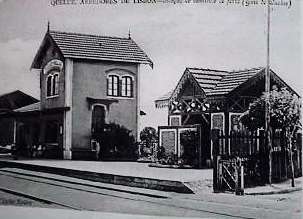
 MONTE ABRAÃO (15km).
This station, (1P2P1) opened originally in the late 1990s as Queluz-Massamá but was renamed c.2004. It serves as a terminus for rush hour services and serves an expanding belt of commuters' homes. Confusingly, after its renaming, the Massamá name was joined to Barcarena station (see below).
MONTE ABRAÃO (15km).
This station, (1P2P1) opened originally in the late 1990s as Queluz-Massamá but was renamed c.2004. It serves as a terminus for rush hour services and serves an expanding belt of commuters' homes. Confusingly, after its renaming, the Massamá name was joined to Barcarena station (see below).
 MASSAMÁ-BARCARENA (17km)
The red roof has a fussy framework support. On leaving there is a stadium (right) and a fast stretch of six tracks before the railway reverts to two tracks (2002), with flats to the left but more rural to the right. Until recently this was a small station (P2P) with some modern shelters and an old station building bearing the former name of Tercena Barcarena. The train now curves to the right, passing a large cement works on the right, whilst to the left there is a mixture of housing and open scrubland.
MASSAMÁ-BARCARENA (17km)
The red roof has a fussy framework support. On leaving there is a stadium (right) and a fast stretch of six tracks before the railway reverts to two tracks (2002), with flats to the left but more rural to the right. Until recently this was a small station (P2P) with some modern shelters and an old station building bearing the former name of Tercena Barcarena. The train now curves to the right, passing a large cement works on the right, whilst to the left there is a mixture of housing and open scrubland.
 AGUALVA-CACÉM (18km)
AGUALVA-CACÉM (18km)
